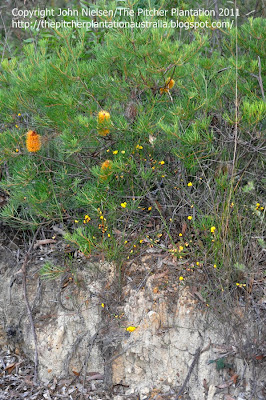Drosera peltata are widely distributed in the Eucalpyt forests here, but I like a small site on the side of the road because the plants here are surrounded by small herbs, making for interesting photos. Elsewhere, they tend to be more obscured with dead Eucalypt leaves, making photography a bit of a challenge. Unfortunately, someone seems to have lit a small fire that burned out much of the adjacent bush, which is busily regenerating. Fire is an important part of many Australian ecosystems, and the plants in particular are generally well adapted to this distiurbance. As a case in point, note the new growth of a Eucalyptus coming up from its rootstock.
As it is still Autumn, I found only a very few D. peltata breaking dormancy. All were in the rosetted stage and had not made any progress towards making a climbing stolon yet. This form of D. peltata is very different to the truly alpine form here in Canberra (f. gracilis) and the one in south-eastern Queensland (f. nipponica).
Just as a teaser, here is a landscape shot of D. peltata in full cry elsewhere in the George's River reserve. Now I have a dedicated macro lens, expect better shots than this in a few months (this was taken with a point-and-shoot on a very clumsy 'manual' focus mode)!
There are a lot of other nice plants in the bush here - growing right above the now rosetted D. peltata was a Banksia, which had a beautiful flower only recently opened.
Another feature of the bush here are Pultenaea, the so-called bacon-and-egg flower. They are of course a member of the pea family (Fabaceae). Their lovely yellow and red flowers are borne on racemes and make a dazzling display. The plant itself is a small scrambler.


And of course there are Pterostylis saxicola. I won't let on where these photos were taken, but they are currently in rosette form. I really like the crystalline-looking 'rivers' that run through the plants' leaves; I assume they allow the plant to make better use of dappled sunlight in the same way some Begonia do in the tropics. I have never quite managed to hit these plants in flower, but will hopefully have better luck this year. Other orchids in this area include at least one more Pterostylis species and the mosquito orchids (Acianthus spp.).










